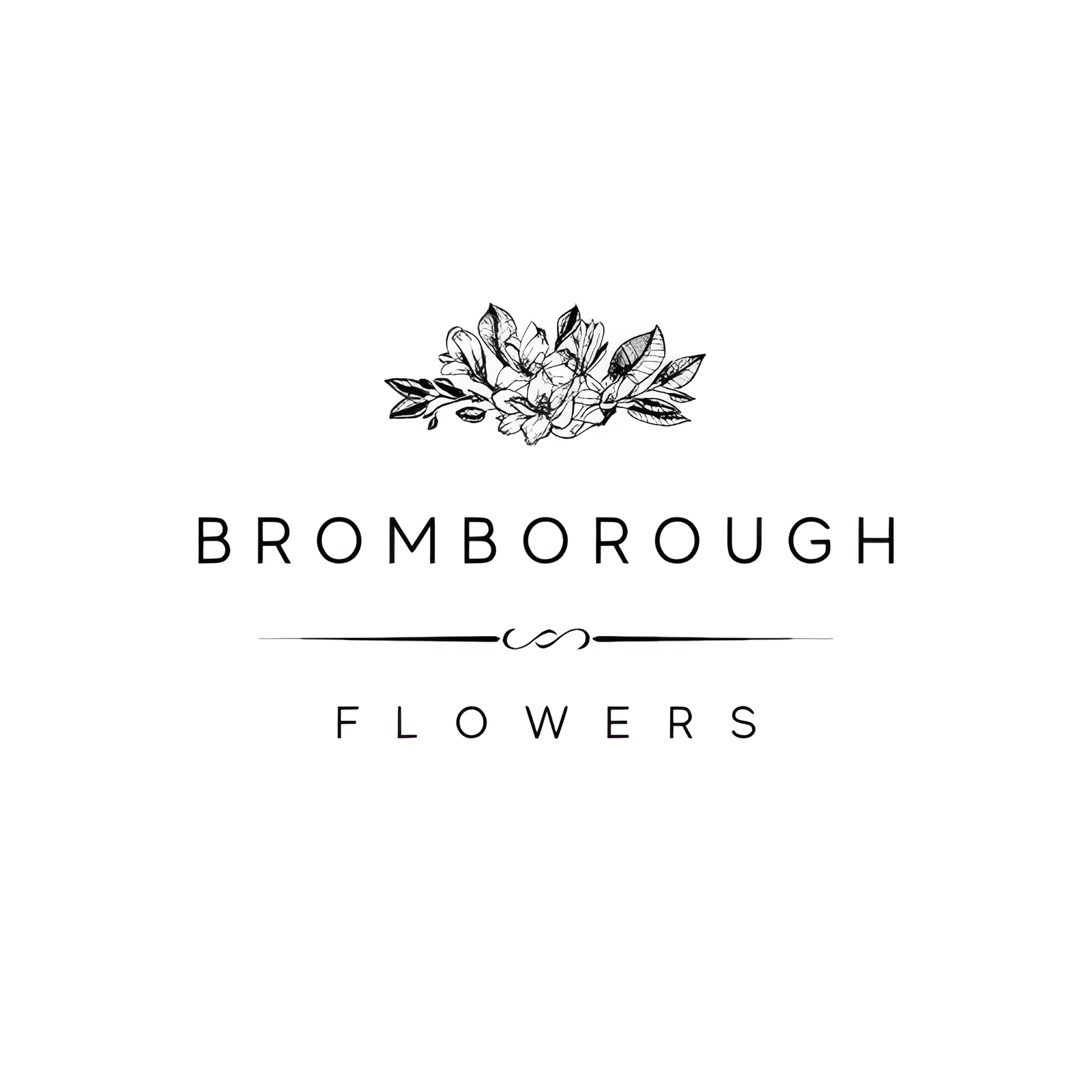When planning a wedding, the choice of flowers can greatly influence the overall aesthetic, and Gloxinia stands out as an exceptional option. With its vibrant, bell-shaped blooms available in an array of colors including purple, pink, red, and white, this elegant flower offers both versatility and visual appeal. Known for its lush foliage and velvety texture, Gloxinia can elevate any floral arrangement, from bouquets to centerpieces. Understanding its growing conditions and cultural significance will provide deeper insights into why this flower is becoming increasingly popular among discerning couples. What makes Gloxinia truly unique in wedding settings? Let's explore further.
Flower Overview
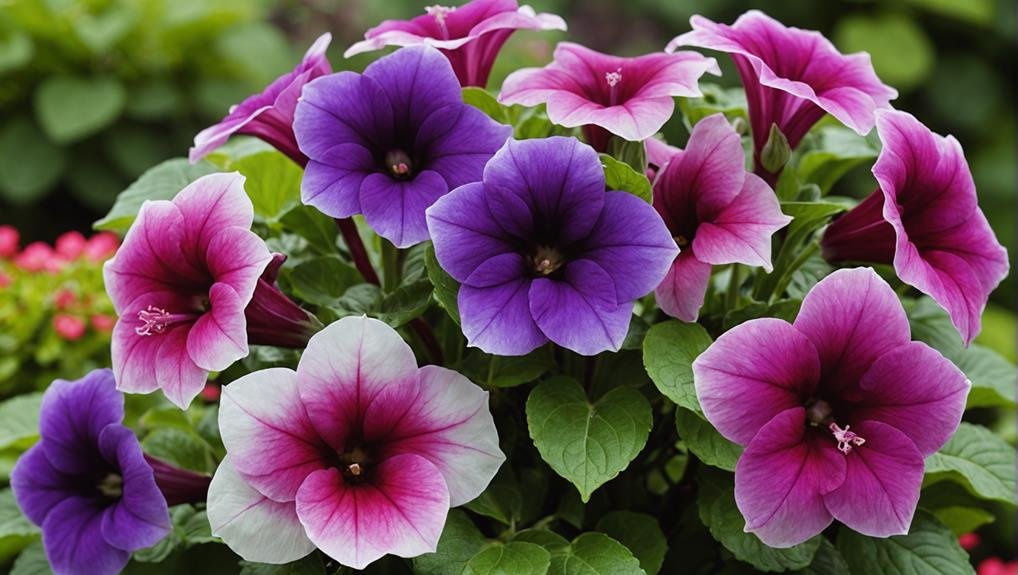
Gloxinia flowers, with their vibrant colors and elegant bell-shaped blooms, are a stunning addition to any wedding arrangement. These stunning flowers come in a variety of shades, including purple, pink, red, and white, making them a versatile choice for diverse wedding themes and color palettes. Gloxinia flowers can add a touch of sophistication and charm to any floral arrangement, whether they are used in bridal bouquets, centerpieces, or other decorative pieces.
Originating from Central and South America, Gloxinia flowers are tender perennials that thrive in bright, indirect light and well-drained soil. Their preference for good air circulation guarantees that they remain fresh and vibrant throughout the wedding festivities. The ability of Gloxinia blooms to uphold their beauty in various conditions makes them an excellent choice for both indoor and outdoor wedding ceremonies.
Incorporating Gloxinia bulbs into wedding floral decorations can enhance the overall aesthetic, providing a rich and elegant visual experience. Their bell-shaped blooms not only add a unique structural element but also contribute to the lush, full appearance of floral arrangements.
Physical Description
Boasting vibrant, bell-shaped blooms, these flowers exhibit a range of colors including purple, pink, red, and white. Gloxinia flowers make a striking addition to any wedding arrangement due to their vivid hues and unique shape. Originating from Central and South America, these tender perennials are well-regarded for their ability to symbolize beauty and grace, making them an ideal choice for wedding decor.
The physical structure of Gloxinia includes lush foliage that complements the stunning flowers, creating a romantic and charming atmosphere. The leaves are generally broad, velvety, and dark green, which enhances the overall aesthetic appeal of the plant. The flowers themselves are typically large, bell-shaped, and possess a velvety texture that contributes to their luxurious appearance.
Gloxinia bulbs are known for producing spectacular blooms with minimal effort, a feature that makes them popular for wedding decorations. These flowers thrive in bright, indirect sunlight, ensuring that they maintain their vibrant colors and lush appearance throughout the event.
Incorporating Gloxinia flowers in wedding bouquets or centerpieces can significantly enhance the décor, offering a unique and eye-catching floral display that is sure to leave a lasting impression.
Available Colour Varieties

With an extensive palette of vibrant hues, these flowers offer a variety of color options to suit any wedding theme. From deep purples to soft pinks, and bold reds to pristine whites, Gloxinia flowers provide a rich spectrum of colors that can enhance any bridal ensemble. Each color carries its own symbolism and can be chosen based on the bridal preferences, ensuring that each floral arrangement aligns perfectly with the desired aesthetic and emotional tone of the event.
The versatility of Gloxinia's color varieties offers numerous decorative possibilities and can serve as a source of bouquet inspiration. Brides can seamlessly incorporate these blooms into their floral arrangements, ensuring perfect theme coordination. Gloxinia flowers can be the focal point in both bridal bouquets and centerpieces, providing a touch of elegance and vibrancy to the wedding décor.
Here is an overview of the available color varieties:
| Color | Symbolism | Bridal Preferences |
|---|---|---|
| Purple | Royalty, Luxury | Elegant, Sophisticated |
| Pink | Romance, Joy | Soft, Romantic |
| Red | Passion, Love | Bold, Dramatic |
| White | Purity, Innocence | Classic, Timeless |
| Mixed | Versatility, Cheer | Diverse, Playful |
These colorful blooms create stunning focal points whether used alone or combined with other flowers, making Gloxinia an excellent choice for any wedding theme.
Latin Name and Taxonomy
Have you ever wondered about the scientific classification of these exquisite blooms?
The Latin name for Gloxinia is Sinningia speciosa, a designation that reflects its place within the botanical hierarchy. This enchanting plant species belongs to the family Gesneriaceae, a group comprised of numerous aesthetically pleasing and horticulturally significant plants.
Sinningia speciosa is classified as a tender perennial, meaning it thrives in warmer climates and can be cultivated year-round in suitable conditions. This classification is essential for those considering Gloxinia for wedding arrangements, as it indicates the plant's needs and longevity. The tender nature of these perennials makes them a sophisticated choice for adding vibrant, elegant touches to various floral displays.
The taxonomy of Gloxinia further classifies it within the broader context of tropical plants. Native to Central and South America, Sinningia speciosa is renowned for its luxurious, bell-shaped flowers that come in an array of colors, including purple, pink, red, and white. This diverse palette makes Gloxinia bulbs a popular selection for wedding bouquets and decorations, capable of complementing a wide range of themes and color schemes.
Understanding the Latin name and classification of Gloxinia is fundamental for making informed choices in floral design.
Geographical Origins
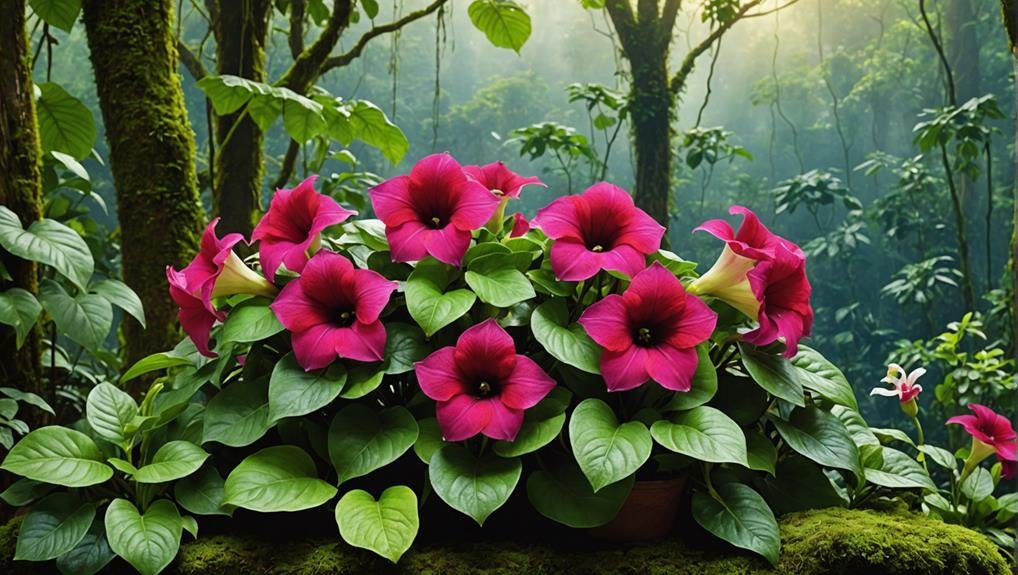
Often celebrated for their striking beauty, Gloxinia plants originate from the lush regions of Central and South America, particularly Brazil and Uruguay. These areas provide the ideal climate and conditions for these tender perennials to thrive. The geographical origins of Gloxinia bulbs contribute significantly to their unique charm and appeal, making them a favored choice in wedding floral arrangements.
Gloxinia's botanical history reveals that they have been admired and cultivated for centuries due to their vibrant, bell-shaped flowers. The plants' rich hues, ranging from purples and pinks to reds and whites, add an elegant touch to any wedding decor. Understanding the regional importance of Gloxinia helps appreciate their enduring popularity and cultural significance in their native habitats.
The environmental impact of cultivating Gloxinia in their indigenous regions is relatively minimal due to their natural adaptability. These plants flourish with minimal intervention, making them a sustainable option for those looking to incorporate eco-friendly elements into their wedding.
Here are some key points about Gloxinia's geographical origins:
- Native to Central and South America, especially Brazil and Uruguay.
- Cultivated for their striking, bell-shaped flowers.
- Vibrant colors enhance wedding floral arrangements.
- Environmentally sustainable due to minimal cultivation needs.
Season Availability
Gloxinia bulbs are mainly available for planting during the spring or early summer months, requiring careful planning to make certain their blooms coincide with your wedding date. Given their growing period of 15-20 weeks, an efficient planting schedule is crucial.
To make sure that these exquisite flowers are ready for your wedding, consider planting gloxinias in late winter or early spring. Starting the bulbs indoors can help control growth conditions, aligning their bloom period perfectly with your special day.
Understanding the best practices for planting gloxinia can greatly enhance your wedding bouquet and centerpiece ideas. These flowers, with their vibrant colors and lush petals, can elevate the aesthetic appeal of your seasonal decor and flower arrangements.
Proper timing and care will yield beautiful blooms that can be used to create stunning wedding bouquets and sophisticated centerpieces, adding a touch of elegance to your event.
Moreover, gloxinias are versatile in their application, fitting seamlessly into a variety of seasonal decor themes. By following a well-planned planting schedule and employing best practices in their cultivation, you can ensure that these flowers contribute significantly to the overall beauty of your wedding flower arrangements.
Growing Conditions
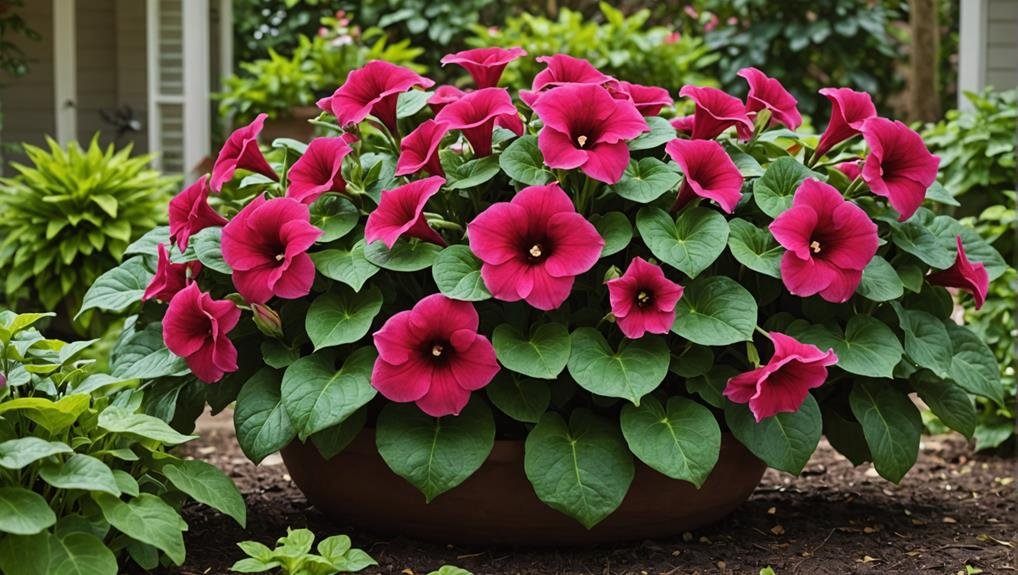
Thriving in bright, indirect light, gloxinia bulbs require well-drained soil and good air circulation to achieve ideal growth. These conditions are essential for producing the vibrant, showy blooms that make gloxinia a favorite in wedding floral arrangements.
When cultivating gloxinia, the following considerations are key:
- Watering Frequency and Potting Techniques:
Gloxinia should be watered moderately, allowing the soil to dry slightly between waterings. Using a mix of peat moss, perlite, and potting soil ensures proper drainage and root health.
- Temperature Requirements and Humidity Levels:
Gloxinia plants flourish in temperatures between 65-75°F (18-24°C). Maintaining a humidity level of around 60-70% is vital for preventing leaf edges from browning.
- Fertilization Schedule and Pest Control Methods:
Regular feeding with a balanced, water-soluble fertilizer every two weeks during the growing season will promote robust growth. Implementing natural pest control methods, such as neem oil, helps deter common pests like aphids and spider mites.
- Light Conditions:
While gloxinias enjoy bright, indirect light, they should be shielded from direct sunlight to avoid scorching. Placing them near north or east-facing windows can provide the ideal light conditions.
Cultural Significance
The symbolic meanings attributed to Gloxinia flowers—love, romance, and beauty—render them an exquisite choice for wedding bouquets and decor. These flowers are not just visually appealing but also steeped in cultural customs and traditions, making them a meaningful addition to any nuptial celebration.
In various cultures, Gloxinia is believed to bring good luck and blessings to the newlyweds, infusing the ceremony with positive energy and fostering a hopeful start to the couple's new life together.
Superstitions and beliefs surrounding Gloxinia flowers further accentuate their cultural significance. Some traditions hold that the deep purple and bright pink hues of Gloxinia symbolize enduring passion and heartfelt affection. The bell-shaped blooms of the Gloxinia, with their delicate and elegant appearance, are often seen as a representation of the unique and special bond between the couple, making them a thoughtful and symbolic choice for wedding floral arrangements.
Incorporating Gloxinia into wedding decor can be viewed as a nod to these rich symbolic meanings and cultural customs, enhancing not only the visual allure of the event but also imbuing it with a deeper layer of cultural and emotional resonance.
Typical Use in Weddings
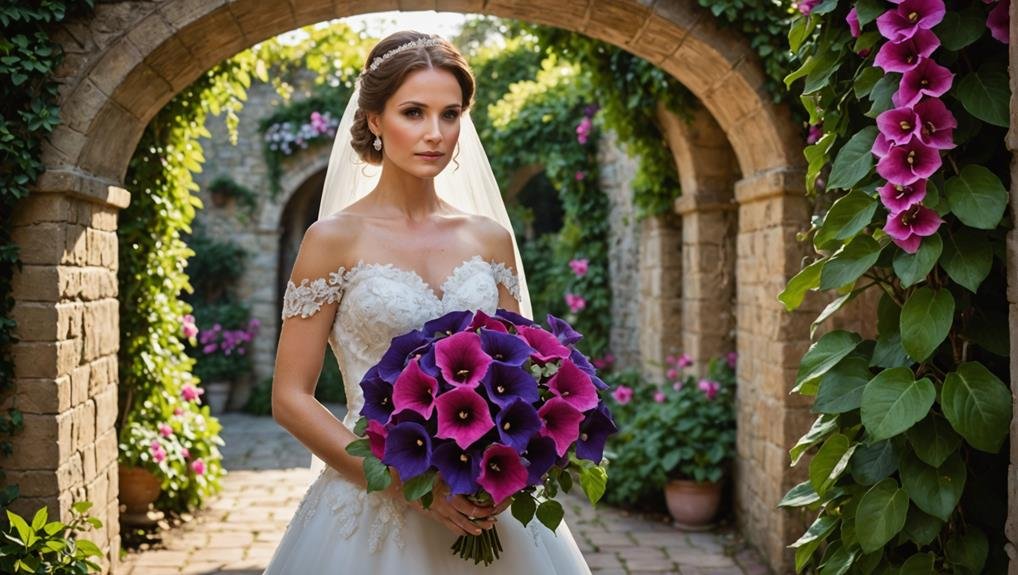
In addition to their rich cultural significance, these vibrant and elegant flowers find practical application in various elements of wedding decor. Gloxinias are a popular choice for couples looking to add sophistication and charm to their special day. Their vibrant colors and elegant bell-shaped blooms make them a standout feature in numerous wedding arrangements. Here are some typical uses of Gloxinia in weddings:
- Floral arrangements, table decor:
Gloxinias are perfect for creating stunning floral arrangements that can be displayed on tables, adding a pop of color and elegance to the reception venue. Their unique shape and vivid hues make them an excellent choice for table decor.
- Ceremony backdrop, bridal bouquet:
These flowers can also be incorporated into the ceremony backdrop, providing a romantic setting for the couple's vows. Additionally, Gloxinias make beautiful additions to bridal bouquets, symbolizing love, grace, and beauty.
- Reception centerpieces, boutonnieres:
For the reception, Gloxinias can be used as eye-catching centerpieces that draw guests' attention. They can also be crafted into boutonnieres for the groom and groomsmen, adding a cohesive and stylish touch.
- Aesthetic enhancement:
Incorporating Gloxinias into wedding decor elevates the overall aesthetic, creating memorable moments for the couple and their guests.
Alternative Flower Types
Exploring alternative flower types like orchids, lilies, roses, and hydrangeas can offer couples a distinctive and personalized touch to their wedding decor. Each of these blooms provides unique colors, shapes, and textures, enabling creative arrangements that cater to a couple's specific vision.
Orchids, for instance, are known for their symbolism of love, luxury, and beauty. Their exotic appearance can elevate any wedding setting, making them a trendy alternative for those seeking elegance.
Lilies, with their association with purity, elegance, and devotion, bring a sophisticated charm to wedding decor. Available in various shades, lilies can be used in unique pairings with other flowers to create visually stunning displays.
Roses, the timeless symbols of love and romance, offer a wide spectrum of colors, ensuring they can complement any wedding theme or color palette seamlessly. Their versatility makes them a staple in wedding floristry.
Hydrangeas, with their voluminous blooms, are ideal for creating lush, impactful arrangements. Their ability to blend with other flowers allows for endless creative arrangements, from bouquets to centerpieces.
These trendy alternatives provide couples with an array of options to craft a memorable and personalized wedding atmosphere.
